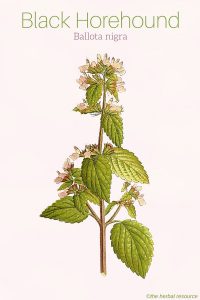Black horehound has a long history of use in herbal medicine and it was once regarded to be helpful for ailments related to eyes and ears.
It was also thought that it was an effective remedy or an antidote of sorts for bites by dogs infected with rabies. Compressions or wraps of the leaves were then placed on the infected areas, which allegedly counteracted the cramps.
Although the herb is still grown to some extent in herb gardens, it is rarely used in today’s herbal medicine due to its unpleasant taste.
Now, its close relative white horehound (Marrubium vulgare) is rather used instead, which has some of the same medicinal properties, is regarded to be more effective and to say the least has a better taste.
An Anti-Nausea Herb
The whole plant is said to have an antispasmodic, expectorant and vermifuge effect and it is especially regarded to be effective in its action as an antiemetic.
Black horehound is therefore sometimes used to curb nausea and vomiting, especially when the cause is related to the nervous system and not to the digestive system.
It can, for example, be used as a remedy for traveling sickness or motion sickness, where the nausea is triggered in the inner ear and central nervous system.
The herb may also be helpful for morning sickness, or nausea caused by stress and anxiety. In that regard, the herb is often used in conjunction with meadowsweet (Filipendula ulmaria) and chamomile (Matricaria recutita).
Black Horehound has Sedative Effect
Black horehound has some sedative properties and it has been used traditionally for the symptomatic treatment of mild forms of nervousness, anxiety, and insomnia in both adults and children.
The herb has also be used as a remedy for loss of appetite, indigestion, intestinal worms, irregular menstruation, some menopause symptoms, and as a mild expectorant agent for treating ailments associated with the respiratory system, such as a sore throat, cough, bronchitis and mild cases of a whooping cough (pertussis).
The gentle sedative effect of black horehound may come from it essential oil, which has an unpleasant odor. Something it has in common with another soothing herb, namely valerian (Valeriana officinalis), which is also known for its unagreeable smell.
In addition, the herb has astringent properties and may be used externally to treat minor skin rashes, insect bites, and sunburn. It can also be applied topically in the form of a compress as a relief for rheumatic diseases such as gout.
[Read more about Black Horehound…]

Leave a Reply